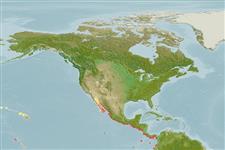>
Carangaria/misc (Various families in series Carangaria) >
Centropomidae (Snooks)
Etymology: Centropomus: Greek, kentron = sting + Greek, poma, -atos = cover, operculum (Ref. 45335).
More on author: Günther.
Environment: milieu / climate zone / depth range / distribution range
Sinh thái học
Biển; Nước ngọt; Thuộc về nước lợ gần đáy. Tropical; 29°N - 0°N, 113°W - 77°W
Eastern Pacific: southwestern coast of Baja California Sur, Mexico and the central Gulf of California to Ecuador.
Bộ gần gũi / Khối lượng (Trọng lượng) / Age
Maturity: Lm ? range ? - ? cm
Max length : 65.0 cm TL con đực/không giới tính; (Ref. 55763); common length : 30.0 cm TL con đực/không giới tính; (Ref. 55763); Khối lượng cực đại được công bố: 3.2 kg (Ref. 40637)
Body slender and not very deep; dorsal profile slightly concave behind the eyes; lateral line extending to posterior edge of caudal fin; second anal spine, when folded down, not reaching origin of caudal fin; pectoral fins shorter than pelvic fins; anal fin with 7 rays; back blue or gray; belly silvery; lateral line dark. Membranes between second and third anal spines black; distal quarter of pelvic fins generally dark (Ref. 55763).
Adults inhabit bays and estuaries (Ref. 37955). Also found in high altitudes of at least 250 m elevation and a distance of some 20 km from the coast. They also occur in coastal waters, but is more abundant in estuaries of any size. Enter freshwaters mostly in large rivers and feeds on fish and crustaceans (Ref. 36880).
Life cycle and mating behavior
Chín muồi sinh dục | Sự tái sinh sản | Đẻ trứng | Các trứng | Sự sinh sản | Ấu trùng
Bussing, W.A., 1995. Centropomidae. Róbalos. p. 987-995. In W. Fischer, F. Krupp, W. Schneider, C. Sommer, K.E. Carpenter and V. Niem (eds.) Guia FAO para Identification de Especies para lo Fines de la Pesca. Pacifico Centro-Oriental. 3 Vols. FAO, Rome. (Ref. 9284)
IUCN Red List Status (Ref. 130435: Version 2024-2)
Threat to humans
Harmless
Human uses
Các nghề cá: Tính thương mại; cá để chơi: đúng
Các công cụ
Special reports
Download XML
Các nguồn internet
Estimates based on models
Preferred temperature (Ref.
123201): 23.3 - 28.6, mean 27.5 °C (based on 36 cells).
Phylogenetic diversity index (Ref.
82804): PD
50 = 0.5005 [Uniqueness, from 0.5 = low to 2.0 = high].
Bayesian length-weight: a=0.00708 (0.00451 - 0.01112), b=3.05 (2.92 - 3.18), in cm total length, based on LWR estimates for this species & Genus-body shape (Ref.
93245).
Mức dinh dưỡng (Ref.
69278): 4.0 ±0.65 se; based on food items.
Thích nghi nhanh (Ref.
120179): Trung bình, thời gian nhân đôi của chủng quần tối thiểu là 1.4 - 4.4 năm (Preliminary K or Fecundity.).
Fishing Vulnerability (Ref.
59153): Moderate to high vulnerability (46 of 100).
Nutrients (Ref.
124155): Calcium = 128 [73, 204] mg/100g; Iron = 1.09 [0.73, 1.62] mg/100g; Protein = 19.5 [17.2, 21.7] %; Omega3 = 0.255 [0.116, 0.568] g/100g; Selenium = 48.6 [27.0, 89.8] μg/100g; VitaminA = 12.2 [5.1, 28.0] μg/100g; Zinc = 1.06 [0.81, 1.42] mg/100g (wet weight);
